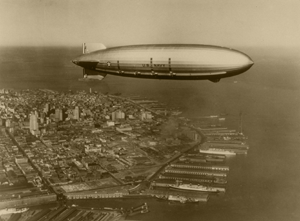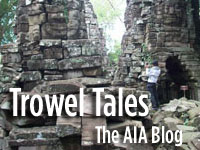Amazing Underwater Sites and Tales
by Mark Rose
February 12, 2010
For anybody who feels that discoveries are the heart and soul of archaeology, the website of the National Oceanic and Atmospheric Administration, NOAA for short, is a great place to explore. Politics and archaeology, repatriation of looted artifacts, preservation of threatened sites, differing perspectives of faith and science on the archaeological record, etc.—these are all very important topics, but discoveries are what draw people, including me, to archaeology.
I was delighted to receive a notice about a press release from NOAA yesterday. It wasn’t about climate change viewed through an archaeological lens, it was simply about a really neat site—the

USS Macon, Moffett Field Historical Society
wreck of the airship Macon, which has just been named to the National Register of Historic Places, a federal government listing here in the U.S. that recognizes exceptionally important sites. Nothing weighty or charged with earth-shaking implications, just a neat site.
What’s NOAA got to do with archaeology? The agency, part of the Department of Commerce, has oversight of national marine sanctuaries here and any cultural heritage within them. So, NOAA has been doing a lot of archaeology, primarily locating and documenting shipwrecks. You may have seen coverage of the investigations of the Civil War ironclad Monitor, one of NOAA’s more ambitious projects, which involved raising some of the ship’s key components such as the revolving gun turret.
The new press release was about a completely different type of vessel. USS Macon was a 785-foot-long dirigible, an immense craft almost as large as the German dirigible Hindenburg, which caught fire landing at Lakehurst, New Jersey, in 1937. Designed to be the eyes of the naval fleet, Macon carried four Sparrowhawk biplanes. It was damaged in a storm off the California coast in 1935 and sank, losing two of its 83-man crew. Today the wreckage of the dirigible and its biplanes are 1,500 feet down in the Pacific within the Monterey Bay National Marine Sanctuary.
Toward the end of the press release I saw a link to the National Marine Sanctuaries Maritime Heritage Program on the NOAA website. I use the NOAA website almost daily to check the weather forecast (go to the www.noaa.gov hompage, enter your zip code, and hit return), but my past use of it as an archaeological source was made difficult because different projects and even reports from one project seemed to be scattered here and there. But the Maritime Heritage Program page is a handy gateway to all of it—37 sites/projects in all. I’m only half-way through reading about them, but thought I would share a few of the stories. You might want to browse all of them yourself.
Alligator, the U.S. Navy’s first submarine. “Conceived by the French inventor Brutus de Villeroi and constructed in Philadelphia in 1861, the Alligator was built to combat Confederate ironclad warships and clear harbor obstructions. Its design was as daring as it was innovative. The first operational submarine to have an air purifying system and the ability to deploy a diver while submerged, the Alligator was in many ways the forerunner of today’s subs. But in April 1863, while being towed south to take part in the attack on Charleston harbor, the Union sub was caught in a fierce storm and cut loose off Cape Hatteras.â€
Queen of Nassau, originally (Canadian Government Ship) CGS Canada. “The steamer CGS Canada was built in 1904 and became the first armed, steel-hulled cruiser owned and operated by the Canadian government…. Canada marked the transition from traditional wooden schooners to modern steel cruisers, playing a crucial role as Canada formulated its young navy. The Canada was the fastest ship in the Fisheries Protection fleet; it was Canada’s first successful naval training vessel, and the first Canadian naval vessel to train with the Royal Navy.”
USS Saginaw, ran aground on Ocean (Kure) Island while checking for castaways while en route to Honolulu. “The castaways [Saginaw crewmembers] established a camp ashore, and the ship’s gig was modified and manned by five volunteers to make the journey east. Ninety three survivors waited on Green Island. Coxswain William Halford was the only one to survive the violent surf landing at Kalihi Kai on Kaua’i after a rough 31 day passage. His Majesty Kamehameha V lent the royal steamer Kilauea to the American minister at Honolulu for the rescue mission, and the remaining crew were picked up on January 3, 1862.â€
USS Macaw (ASR-11), a submarine rescue and salvage vessel that ran aground trying to reach the submarine Flier (SS-250), which had been pushed by high winds onto a coral reef at Midway. “By 6:00 PM the pronounced list was suddenly reduced as Macaw’s stern swung south and submerged in deeper water. Urgent messages were sent to the crew on board the wreck not to attempt to abandon ship as it was felt that all would be killed on the coral reef or possibly even before clearing the vessel. All communication with Macaw was lost at 9:00 PM as the pilothouse began to be submerged by breaking seas. Searchlights were trained on the site, and search-and-rescue parties were organized ashore on Eastern Island….â€
Dunottar Castle, a three-masted British ship that struck a reef in 1886. The chief officer and six seamen took one of the ship’s boats and made it to Kauai in 52-days, during which time another vessel saved the rest of the crew. “Meanwhile, back in Honolulu the steamer Waialeale was jointly chartered by the British commissioner in Honolulu and by the Kingdom of Hawaii and sent on a (now redundant) emergency mission to the distant atoll. Only the three dogs which had been left behind, two terriers and a retriever, were there to be rescued.â€
Kad’yak, a three-masted bark built for the Russian-American Company. “Throughout the first half of the nineteenth century the Russian American Company established settlements in Alaska, initially to trap furbearing animals. Later, these settlements became largely self sufficient by taking advantage of Alaska’s tremendous natural resources. Russian-American Company ships sailed half way around the world to provide luxury items not available locally and brought news from home.†Kad’yak sank near Kodiak Island in 1860.
(See our story “Tracking Down Kad’yak.â€)
Enjoy the stories about these sites and projects. You might have to pursue some, as the introduction on this site is occasionally linked to additional pages elsewhere (as with Monitor and Alligator). And it isn’t always clear where projects stand now—some have updates from a couple of years back, then nothing. But overall, the site is worth having a look at. One page has an interactive map of projects, but not all appear on it or in the drop down menu, so best to go to http://sanctuaries.noaa.gov/maritime/expeditions/mh_expeditions.html.
For more about Macon, click here.
Comments posted here do not represent the views or policies of the Archaeological Institute of America.






 Heather Pringle is a freelance science journalist who has been writing about archaeology for more than 20 years. She is the author of Master Plan: Himmler's Scholars and the Holocaust and The Mummy Congress: Science, Obsession, and the Everlasting Dead. For more about Heather, see our
Heather Pringle is a freelance science journalist who has been writing about archaeology for more than 20 years. She is the author of Master Plan: Himmler's Scholars and the Holocaust and The Mummy Congress: Science, Obsession, and the Everlasting Dead. For more about Heather, see our 



